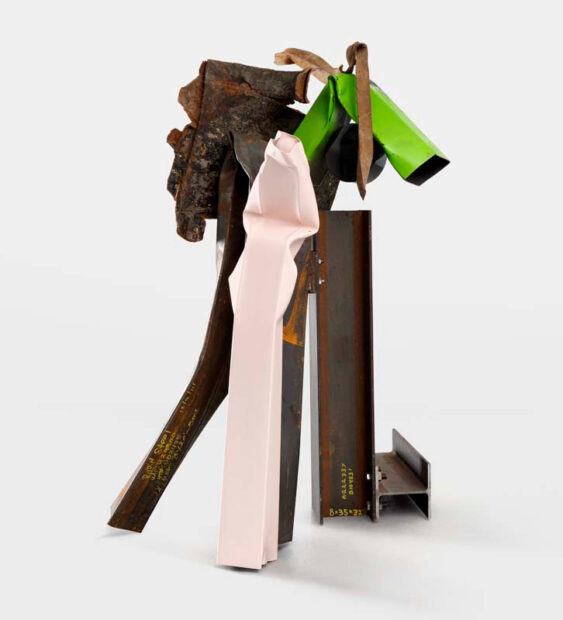Carol Bove is a magician. She cleverly reinvigorates the tradition of gigantic, supposedly heroic, and weighty commercial steel sculpture, subverting the usually orotund voice present in this type of artwork. Through a series of small decisions, she transforms the historically macho form: cajoling and wriggling humanness into what is, by all accounts, a Bermuda triangle of art production. We’ve all bumped into the anonymous steel sculptures that sit outside company headquarters or at the entrances to business parks. Squatting in public spaces, they are positioned to serve as visual calling cards for the business at hand, or as self-congratulatory trophies of philanthropy. They are obstructive and utterly forgettable. Bove traffics in this formulaic territory, finding a means to resuscitate the inconsequential into something that has verve and wit. Like the equally funny Rachel Harrison, Bove is rewriting our understanding of this genre of artwork into something more lighthearted and scaled-down. Where Harrison is often ringing an absurdist slapstick bell, Bove seems to be genuinely enamored and curious with the material, appearing partially sensitive to the history of steel sculpture and partly puckish toward its usual bravado.
In Hylomorph I (2016), Bove references Aristotle’s suggestion that all physical objects are birthed through the subtle combination of matter and form. Here Bove seems to point toward how the inert substances she uses to make her sculptures only take life through a careful discovery within the processes of bending, warping and adjacent fusing. In Hylomorph I the leaning steel has a loosely pyramidal shape that seems decidedly human. From different angles it can either read as rigid or floppy; one can imagine the various heavy materials as legs, feet, heads, or even hair. There is a touch of Claus Oldenburg or a hint of John Chamberlain in the bendy and crumpled steel parts Bove uses. Yet Bove’s art feels refined and elegant in ways that are unique.
Important sections of the artwork’s surface are painted matte pink or a mid-toned green. The shock of specific colors offsets the other rusty steel patinas, highlighting how Bove’s sensitivity to painting matches her eye for manipulation of hulky sculptural arrangements. In fact, she is careful to contrast each natural or manipulated pigmentation of steel. The bent green tubing is abraded at the elbow, while underneath a pill-like shape is cradled, revealing a shiny black that is cleanly perfect in its dark opacity. These changes in surface underscore each texture and mottled pattern as worthy of our detailed observation.
Perhaps the roughly worn to pristine variation of the sculpture is a reference to our own bodies’ aging and weathering by time and incidence. Either way, Bove expertly pulls us into nuance; notice in the crinkled pink french-fry shape how there is a small crack and bend at the base of the form. This little rupture nearly kisses the ground with a touch of delicacy that’s rarely seen amongst large steel beam artworks, but is regularly seen in Bove’s finely tuned sculptures.
Carol Bove: Collage Sculptures is on view through January 9, 2022 at the Nasher Sculpture Center in Dallas.



